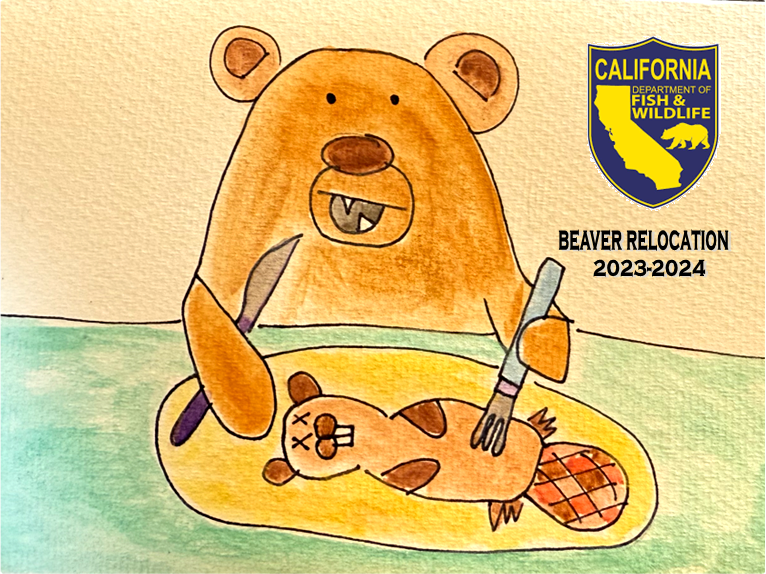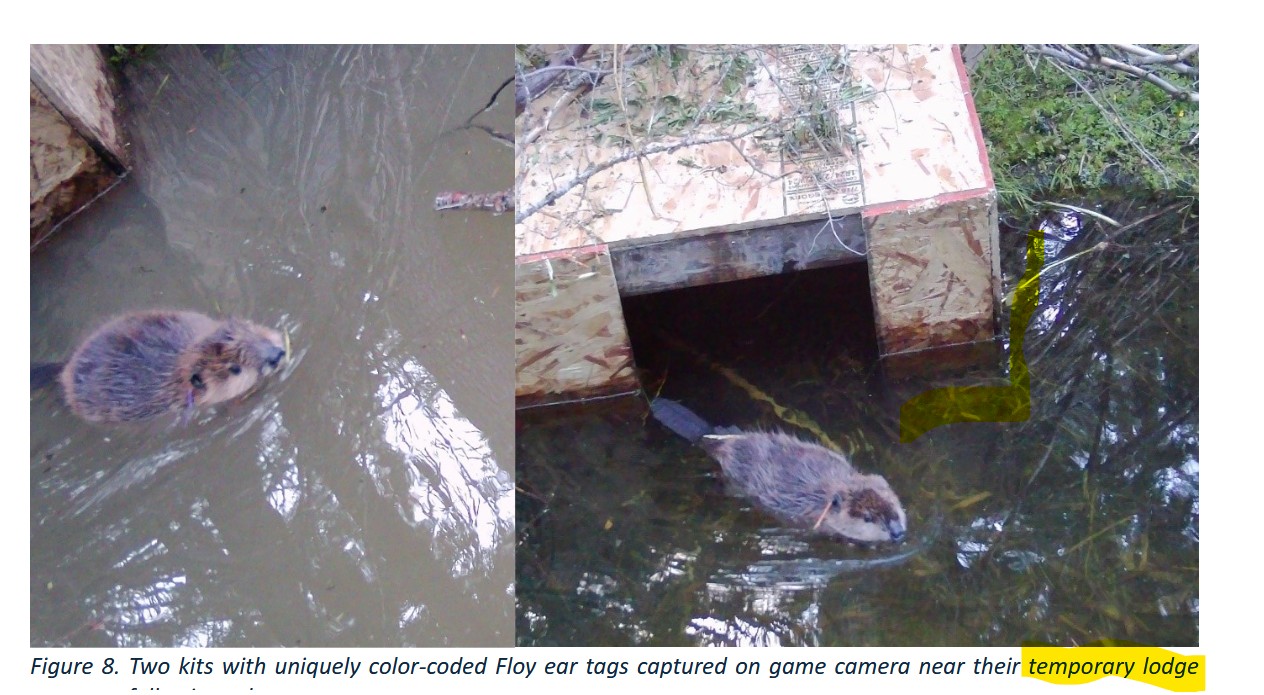
Author: heidi08
Twenty days ago CDFW released the two year summary of their highly acclaimed “beaver relocation plan”. It was hailed with a reception of cheer and inspiring footage of Mr, Bonham himself saying we were better with beavers on the land. Our beaver friends around the state high-fived each other and drank in the success.
I was not among them.
I carefully viewed and reviewed the report, talked to colleagues and researched details, then I wrote a two page review of their report. I carefully sent it it to all the right places and gave them time to respond. I heard nothing back so I waited.
And waited,
Two weeks later I’m assuming they tossed my remarks in the circular file and I’m instead going to share them here. I cannot guess whether they will ever be read, but I can no longer keep them silent. I can only hope that one of the reasons Molly Alves was hired to direct this team is because at some level folks saw this was as much of a clusterf*ck as I did.
The painting was a special favor by Erika and I thought of it later but may still send it If I don’t talk myself down from the ledge.
Advice is a dangerous gift, even from the
wise to the wise, and all courses may run ill.”
― J.R.R. Tolkien, The Fellowship of the Ring
One can read this quote and easily replace the word “Advice” with the word “Beavers”. Because even when translocation is done in the best way for the best reasons things can still turn horribly wrong.
Reading your April report on the beaver releases proves the point: the high mortality rate of “40-60” percent and perceived lack of clarity on beaver biology and behavior is disappointing, I realize this project is a work in progress and you are learning as you go, but the effort is using limited taxpayer dollars and finite human goodwill so of course everyone wants that learning curve to be as brief as possible.
The best parts of the report focus on restoration and hydrological gains attributed to the beavers. This made the mostly hopeful minds that reviewed it feel cheered by the projects success. However, since my perspective is wholly beaver-centric I am much more alarmed.
Other than stating that the beavers in question were “causing depredation” on municipal state or conservancy land you do not clarify who did the trapping. I assume they were not very good at it because it took them 561 days to trap 30 beavers. And one was so traumatized that he died of a heart attack.
 At a rate of a single beaver every three weeks we can assume your trappers were mostly doing something else on those 561 nights, maybe even lethal trapping. Their success rate suggests that the skill sets for the two are very different.
At a rate of a single beaver every three weeks we can assume your trappers were mostly doing something else on those 561 nights, maybe even lethal trapping. Their success rate suggests that the skill sets for the two are very different.
In the maidu release you say that “7 members of the same family” were taken including
an adult breeding pair, one subadult, and four kits from two litters; three were larger, early-season kits and one was a small, late-season kit.
Kits born to the same family are all from a single season. Female beavers enter estrus only once a year and all their litter is born at the same time. The only way there could be two litters is if there were two females. Certainly over the 10 years we closely observed our family of beavers we occasionally saw a litter with beavers of very different sizes but they were still from the same season, as all yours were unless you accidently ‘kitnapped’ a beaver from another family.
When tagging the beaver for data collection the burden on the animal must be weighed against the usefulness or value of the data given. Certainly providing an animal with different color eartags that will never be visible on night cam (which since beavers are nocturnal is the only time they’ll ever be filmed) is of limited value. Tail monitors, while convenient, are cumbersome and often torn loose by an animal that is constantly moving and removing brush.
 Of course any reader Is likely to be alarmed by the high predation rate. it is neither humane nor cost effective to reintroduce beavers solely to enrich the diet of black bears. It is concerning that you were so unaware of predator population in the selected release sites. Moreover, the photo provided of the perhaps well meaning ‘temporary lodge’ reflects a deep ignorance of beavers and the purpose of a lodge in the first place.
Of course any reader Is likely to be alarmed by the high predation rate. it is neither humane nor cost effective to reintroduce beavers solely to enrich the diet of black bears. It is concerning that you were so unaware of predator population in the selected release sites. Moreover, the photo provided of the perhaps well meaning ‘temporary lodge’ reflects a deep ignorance of beavers and the purpose of a lodge in the first place.
Obviously in order to provide safety of any kind the entrance of that lodge must be UNDER WATER, The report indicates you stopped offering lodges because
we ultimately found that these likely increased the risk of predation by attracting predators

No kidding!
Maybe the lodge in the photo was pre-manufactured before you knew the depth of the water. As a result it sits neatly on the soil and means that any beaver can get in but is ruthlessly trapped in the lodge if pursued. The notion that you would include this photo in your report suggests that even now you don’t understand why its so inadequate and you assume no one reviewing the report will understand it either.
I saw this summary covered in the news in celebratory tones and watched my creek-restoring colleagues high-fiving at the successful dams and water storage. To my reading that means that the dislocated beavers that were lucky enough to avoid predation did an excellent job adapting to their new surroundings and forcing their new surroundings to adapt to them.
However, the educated professionals paid by the state of California were less successful. You are charged with protecting the public interest in wildlife, preserve natural resources that benefit our streams and woodlands, improve biodiversity and restore beaver presence on the landscape in a way that benefits their repopulation and our own interests in sport fishing, duck hunting, and fire resilience. This report indicates that to date you have not yet got it right.
It is my strongest recommendation that you have this report reviewed by beaver relocation experts in both Washington state and Oregon where this work has been well understood for decades. I recommend Alexa Whipple who runs the beaver reintroduction program at the Methow Project and Vanessa Petro with Oregon forests who did beaver relocation research under Dr. Jimmy Taylor at USDA. I also advise that you bring an experienced rehab practitioner to both wildlife holding facilities to evaluate the best ways to minimize trauma during capture and housing. Both Sonoma Wildlife and UCDavis have extensive experience rehabilitating beaver and can help improve your efforts.
The state of California has come a very long way in a very short time in recognizing why our state deserves and is benefitted by a healthy beaver population. We still have a long way to go and years of catching up to do.
Keep trying and do better.
And just in case you have a hard time remembering the original, here it is in all its scientific gory glory.
Well those around Okanagan B.C. anyway…
Got beavers? Okanagan landowners wanted for program that can help
Anyone with busy beavers on their property knows their natural activities can be a hassle, as the critters can plug up culverts and build dams that cause flooding and elevated water flow.
Some property owners respond by setting kill traps to remove beaver colonies, but Kelowna resident Eva Hartmann is working to change that, as she completes her studies with the Beaver Institute, an organization in the United States.
“Through my program I’m becoming more knowledgeable in helping property owners resolve beaver conflicts without resorting to kill-traps,” Hartmann told iNFOnews.ca said. “The problem is always increasing as our urban spaces expand.”
Hartmann is the executive director of the Interior Wildlife Rehabilitation Society in Summerland and has years of experience working with wildlife, including orphaned beavers, but said this project is separate from the society, and she can’t complete the program without the public’s help.
She is looking for a property owner in the Okanagan who needs help dealing with beavers that have dammed a creek or blocked a culvert on their property, posing a flooding risk for roads or nearby buildings.
“Beavers live in smaller streams or rivers where there are culverts installed under the roads for the stream to flow through and if the beaver plugs the culvert it causes flooding,” she said. “The roads flood frequently if the culverts are unprotected, which can be mitigated by putting the correct kind of fencing on it.
Here that girls and boys? She’s working with the beaver institute and can help you! This is my favorite part:
Through her role with the Interior Wildlife Rehabilitation Society, Hartmann and her team have rehabilitated and relocated beavers to suitable habits along with help from local conservation groups and First Nations, projects that are lengthy and complicated.
She is working to prevent beavers from being killed, injured or orphaned in the first place. Beavers do important work in the environment by slowing and spreading the flow of water with their dams, making water tables higher.
Hear that? NO MORE ORPHANS!!! Finally a rehabber who doesn’t just put videos of cute babies on Youtube. She’s trying to prevent orphans in the first place!
Headquartered in North Vancouver, the Fur-Bearers is a wildlife protection charity that works to protect fur bearing animals through conservation, advocacy, research and education.
So far, Hartmann hasn’t found a property owner to collaborate with.
“It’s a little tricky as beavers are still mostly kill-trapped if anyone in B.C. has issues with them,” she said. “Installations like this are happening all over Canada and the states, there are companies with experience in doing this, but B.C. is lagging behind.
“It’s time we catch up and stop taking the easy way out by defaulting to kill-trapping.”
If you’d like to reach out to Hartmann to see if your property is a fit for the program send an email her at Eva@interiorwildlife.ca.
Be brave. Flow devices work longer that trapping. We solved our problem in Martinez for a decade. How long does kill trapping guarantee you won’t have beavers?
I thought so.
I’m having an exciiting keyboard morning at the moment so I’m going to entertain you with a charming beaver meet and greet for the time being.
Worth A Dam has been blessed and fortunate in ways we can never deserve her or thank you enough. She sent me her sketch for the next festival cover. I thought you want a peek.







































